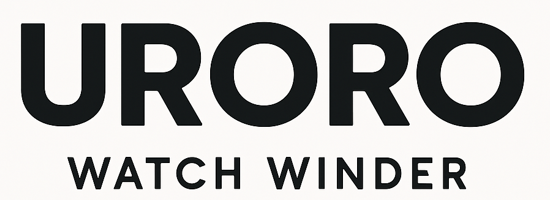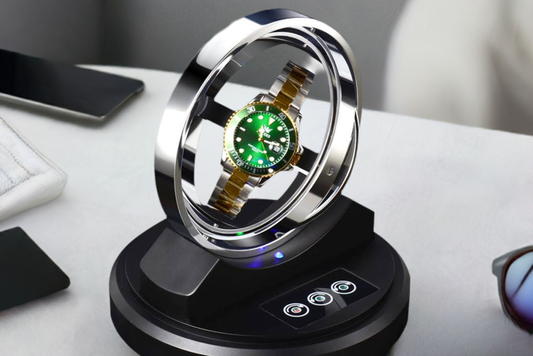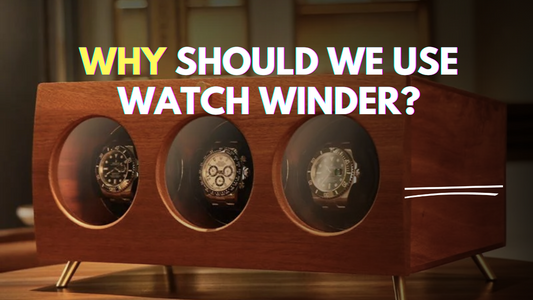Rolex is one of the most iconic and sought-after luxury watch brands in the world. However, with its popularity comes the risk of counterfeit watches. In this comprehensive guide, we'll explore the key factors to consider when identifying a genuine Rolex watch, ensuring that your investment is the real deal.
The Sound Test: Silent vs. Ticking
One of the most significant differences between a genuine Rolex and a counterfeit is the sound of the watch's movement. Genuine Rolex watches are known for their exceptional craftsmanship and precision engineering, resulting in a silent operation. In contrast, fake Rolex watches often produce a distinct ticking sound, indicating a lower-quality quartz movement.
To perform the sound test, simply hold the watch up to your ear. If you hear a clear ticking sound, it is likely that the watch is not genuine. Authentic Rolex watches, particularly those with automatic movements, operate silently due to the precision engineering of their mechanical components.
Credit: YouTube Channel - Adrian Barker
The Weight and Heft Comparison
Another crucial aspect to examine when identifying a genuine Rolex is the weight of the timepiece. Authentic Rolex watches are typically heavier than their counterfeit counterparts due to the high-quality materials used in their construction.
Genuine Rolex watches often feature 904L stainless steel, a high-quality alloy that is more dense and heavier than the 316L stainless steel commonly used in fake Rolexes. The 904L stainless steel is particularly resistant to corrosion and is prized for its durability and strength, contributing to the overall weight of the watch.
To illustrate this difference, a genuine Rolex Submariner typically weighs around 155 grams for the stainless steel version, while a counterfeit Submariner might weigh as little as 80 grams. Similarly, the Rolex Daytona can weigh up to 140 grams in its stainless steel variant, while a fake Daytona might weigh around 90 grams.
Verifying the Engraved Serial and Model Numbers
To identify a genuine Rolex watch, one crucial step is to verify the engraved serial and model numbers located between the lugs. Examine the numbers, ensuring they are deeply etched and not superficial. Genuine Rolex watches have serial and model numbers that are deeply engraved into the metal, creating a clear, crisp, and well-defined impression.
The serial number on a genuine Rolex watch typically starts with a letter followed by a series of numbers, while the model number is usually a combination of letters and numbers. Both the serial and model numbers should be precisely engraved, with no signs of scratches, smudging, or unevenness.
To further authenticate the engravings, compare them to official Rolex documentation or consult with an authorized Rolex dealer. They can verify the serial and model numbers against Rolex's official records to ensure the watch is genuine.
The Micro-Etched Crown Logo
For post-2002 models of Rolex watches, one of the key features to look for is the micro-etched crown logo located at the 6 o'clock position on the crystal. This subtle detail is a testament to Rolex's dedication to precision and security. The logo is so small that it often requires a magnifying glass to see clearly, making it a challenging feature for counterfeiters to replicate accurately.
Locating the Serial Number Correctly
To verify the authenticity of a Rolex watch, one of the most crucial steps is to locate the serial number correctly. The serial number serves as a unique identifier for each Rolex watch and holds significant importance in the authentication process.
The serial number can be found engraved between the lugs at the 6 o'clock position on the case. This location is specific to Rolex watches, so it is essential to check here first. For some older models, the serial number might be engraved on the inside of the case back, which typically requires the watch to be opened by a professional watchmaker or an authorized Rolex dealer.
Examining the Crown Craftsmanship
When examining a Rolex watch, one of the most critical components to verify its authenticity is the crown. A genuine Rolex crown features flawless fluting, which refers to the pattern of grooves or ridges on the crown. The fluting should be symmetrical, evenly spaced, and free of any imperfections.
The Rolex Coronet logo is another significant indicator of authenticity. On a genuine Rolex watch, the Coronet logo is engraved on the crown, typically at the 6 o'clock position. The logo should be sharp, clear, and evenly proportioned.
The size and proportion of the crown are also critical in identifying a genuine Rolex. Compare the crown size to the watch case diameter to ensure they are proportionate. Genuine Rolex crowns are typically made from high-quality materials, such as 18k gold, stainless steel, or titanium, depending on the watch model.
Perfect Alignment and Finish of the Dial
When analyzing the dial for impeccable alignment of markers and the Rolex signature, several key factors come into play. The markers, including the hour markers, minute markers, and any additional features such as date windows or chronograph sub-dials, should be perfectly aligned and symmetrical. Any slight misalignment or uneven spacing between the markers can be a red flag indicating a counterfeit watch.
The Rolex signature, which typically appears at the 12 o'clock position, should be crisp, clear, and precisely centered. The font style, size, and spacing of the signature should match the authentic Rolex design.
To further verify the authenticity of the dial, inspect the finish for any signs of imperfections. The dial should have a smooth, even finish without any scratches, blemishes, or unevenness. The printing on the dial, including the markers and text, should be sharp and well-defined, with no signs of smudging or fading.
The Mastery of Rolex's In-House Movements
Rolex's commitment to in-house movements is a testament to the company's dedication to quality, precision, and innovation. By controlling every aspect of the movement's design, production, and testing, Rolex ensures that its timepieces meet the highest standards of performance, reliability, and accuracy.
Some of the key features that set Rolex movements apart include the Chronergy escapement, which increases the efficiency of the movement and reduces energy consumption, the Parachrom hairspring, which provides exceptional resistance to shocks, temperature fluctuations, and magnetic fields, and the high-performance wheels, which optimize the movement's efficiency and accuracy.
Notable Rolex movements include the Calibre 3255, which powers the Day-Date 40 and boasts a 70-hour power reserve, the Calibre 2236, which powers the Lady-Datejust and features a 55-hour power reserve, and the Calibre 4130, which powers the Cosmograph Daytona and boasts a 72-hour power reserve.
Clasp Signatures: Unveiling the Authenticity
The clasp is often overlooked, but it can reveal a wealth of information about the watch's authenticity. A genuine Rolex clasp features the Rolex logo neatly engraved or stamped, depending on the model. The logo should be symmetrical and evenly spaced, with a clean and crisp font.
In addition to the logo, a genuine Rolex clasp will feature a unique serial number. This number is usually engraved on the clasp and can be used to verify the watch's authenticity through Rolex's official website or authorized dealers.
A genuine Rolex clasp is also a marvel of precision engineering. It should be constructed from high-quality materials, such as stainless steel or gold, and should feature a smooth, seamless mechanism. The clasp should open and close with a satisfying click, and the links should be securely attached.
The Importance of Original Packaging and Documentation
The presence of authentic accompaniments such as the original packaging and documentation plays a crucial role in identifying a genuine Rolex. A genuine Rolex box is typically made of high-quality materials, such as wood or leather, and features the Rolex logo embossed on the lid. The box itself is designed to protect the watch during transportation and storage while also showcasing the brand's commitment to luxury and attention to detail.
In addition to the box, a genuine Rolex comes with a set of papers that serve as proof of authenticity. These papers include the warranty card, the instruction manual, and the certificate of authenticity. Each of these documents contains specific information that can be verified with Rolex to ensure the watch's legitimacy.
To ensure the authenticity of a Rolex box and papers, carefully examine them for any signs of wear, damage, or tampering. Check the weight, build quality, and logo for any inconsistencies. Verify the serial number on the box with the one engraved on the watch, and inspect the papers for any signs of tampering, alterations, or inconsistencies.
Consult an Expert When in Doubt
When it comes to identifying a genuine Rolex, consulting an expert is crucial. A certified watchmaker who specializes in Rolex authentication can provide invaluable insights and ensure that your watch is genuine.
The authentication process typically involves a thorough inspection of the watch, both internally and externally. The certified watchmaker will examine the watch's case, dial, hands, and movement, looking for any signs of tampering or inconsistencies. They will also check the serial number to verify its authenticity against Rolex's official records.
Having a certified watchmaker authenticate your Rolex offers several benefits, including peace of mind, knowing that your watch is genuine and not a counterfeit, a potentially higher resale value, and the identification of any potential issues with the watch, allowing for prompt repairs or maintenance.
Debunking Common Myths and Avoiding Pitfalls
When it comes to identifying genuine Rolex watches, there are several common misconceptions and pitfalls that can lead to incorrect authentication. It's important not to rely on visual inspection alone, as high-quality fakes can be extremely difficult to distinguish from genuine Rolex watches without proper expertise and tools.
Understanding the weight and materials of authentic Rolex watches can help, but it's not a foolproof method, as some high-end fakes can mimic the weight and materials of genuine watches. Genuine Rolex watches have deeply engraved serial numbers and model numbers in designated parts of the watch, while fake watches often have shallow, acid-etched numbers that appear sandy-like and may be placed in incorrect parts of the watch.
The dial and Cyclops lens of a genuine Rolex are meticulously crafted, with consistent fonts, spacing, and markings. The Cyclops lens should have strong magnification and be precisely centered over the date. The second hand of a genuine Rolex should move in a smooth, continuous motion, except for the Rolex Oysterquartz, which is powered by quartz movements and thus ticks every second.
A real Rolex crown should have clear markings and a fluted design, with the Rolex Coronet design on the crown and the presence of dots (or bars) underneath the Coronet. Rolex watches, except for the Cellini dress watch and Perpetual 1908, are equipped with an Oyster case that ensures water resistance, while fake Rolex watches will not withstand the same water pressure levels as genuine ones.
Due to the complexity of Rolex watches and the sophistication of counterfeiters, it is highly recommended to work with a reputable jeweler or authorized Rolex dealer for professional assistance in verifying authenticity and ensuring that you purchase a genuine Rolex watch.
Conclusion
Mastering the art of identifying genuine Rolex watches requires a keen eye for detail and a thorough understanding of the brand's unique features and craftsmanship. By examining the sound, weight, engravings, micro-etched crown logo, serial number, crown craftsmanship, dial alignment and finish, in-house movements, clasp signatures, and original packaging and documentation, you can significantly increase your chances of spotting a genuine Rolex.
However, due to the complexity of these luxury timepieces and the sophistication of counterfeiters, it is always recommended to consult with a certified watchmaker or authorized Rolex dealer when in doubt. By taking these steps and educating yourself on the intricacies of Rolex watches, you can protect your investment and wear your genuine Rolex with confidence.
We hope this comprehensive guide has provided you with valuable insights into identifying authentic Rolex watches. If you found this article helpful, please share it with your fellow watch enthusiasts and leave a comment below with your own experiences or tips for spotting genuine Rolexes. Together, we can help combat counterfeiting and ensure that the legacy of Rolex continues to thrive.
Frequently Asked Questions
1. What should I do if I suspect my Rolex is a counterfeit?
If you suspect that your Rolex is a counterfeit, the first step is to have it authenticated by a certified watchmaker or an authorized Rolex dealer. They have the expertise and tools necessary to thoroughly examine the watch and determine its authenticity. If the watch is confirmed to be a counterfeit, it is essential to report it to the appropriate authorities and avoid reselling it, as this perpetuates the issue of counterfeit watches in the market.
2. Can I authenticate a Rolex watch myself?
While it is possible to learn about the various features and characteristics of genuine Rolex watches, authenticating a Rolex watch yourself can be challenging, especially if you are not experienced in handling luxury timepieces. Counterfeiters have become increasingly sophisticated in replicating the appearance and feel of genuine Rolex watches, making it difficult for the untrained eye to spot a fake. It is always recommended to seek the assistance of a certified watchmaker or an authorized Rolex dealer to ensure the authenticity of your watch.
3. How can I ensure I am buying a genuine Rolex watch?
To ensure that you are buying a genuine Rolex watch, it is essential to purchase from a reputable source, such as an authorized Rolex dealer or a trusted pre-owned luxury watch retailer. These sellers have the expertise and resources to authenticate the watches they sell and often provide a certificate of authenticity and a warranty. When purchasing a pre-owned Rolex, always request documentation, such as the original box, papers, and service history, to help verify the watch's authenticity and condition. If a deal seems too good to be true, it probably is, so be cautious of sellers offering heavily discounted prices or claiming to have rare or limited-edition models.
4. What should I do if I inherit a Rolex watch and want to verify its authenticity?
If you inherit a Rolex watch and want to verify its authenticity, the best course of action is to take it to a certified watchmaker or an authorized Rolex dealer. They can examine the watch and provide an expert opinion on its authenticity and condition. In some cases, they may also be able to provide information about the watch's history and value. It is essential to gather any available documentation, such as the original box, papers, or service records, as these can help in the authentication process and potentially increase the watch's value.
5. Are there any online resources to help identify genuine Rolex watches?
There are several online resources available to help identify genuine Rolex watches, such as official Rolex websites, watch collector forums, and luxury watch blogs. These resources often provide detailed information on the various features and characteristics of genuine Rolex watches, as well as tips for spotting counterfeits. However, it is essential to exercise caution when relying on online resources, as not all information may be accurate or up-to-date. When in doubt, always consult with a certified watchmaker or an authorized Rolex dealer for the most reliable and accurate information on authenticating a Rolex watch.




